This is a break to your heel bone
Healing:
It can take up to 6-12 weeks for this fracture to heal.
Smoking will slow down your healing. We would advise that you stop smoking while your injury heals. Talk to your GP or go to www.smokefree.nhs.uk for more information.
Pain and swelling:
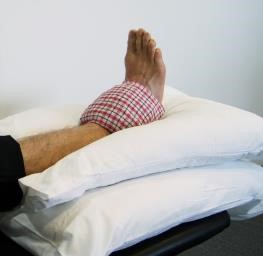
You may have foot pain and swelling for 3-6 months after your injury. Swelling is often worse at the end of the day.
Taking pain medication, elevating your foot and using ice or cold packs will help. More information is in the next section.
Walking and your boot:
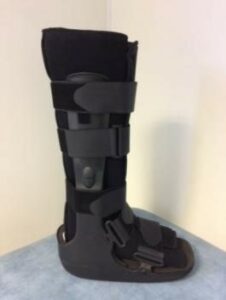
You should not put any weight through your injured leg and should use crutches to move around.
The boot protects your foot and will make you more comfortable. You can take it off at night, at rest or when completing the exercises below. You need to wear the boot for at least 6 weeks after your injury. Please inform us if you are diabetic; you may require a specialist boot.
Exercises:
It is important to start exercises as soon as possible. Instructions are in the next section.
Follow up:
You will receive a face to face appointment in the Fracture Clinic 6 weeks after your injury. If you have not received your appointment letter within 2 weeks please contact the Fracture clinic.
Any questions:
If you are concerned about your symptoms, are unable to follow this rehabilitation plan or have pain other than at the site of your injury please contact the Virtual Fracture Clinic team.
Caring for your injury
DVT (deep vein thrombosis):
DVT (deep vein thrombosis) is a blood clot in a vein, usually the leg. Because you are non-weight bearing, you may be at higher risk of developing a DVT. You may have been given some blood thinning medication to cover you for this period of time. However, if you are under 16, you will not be given a blood thinner unless you are taking an oral contraceptive.
Symptoms of DVT in the leg are:
- throbbing or cramping pain in 1 leg (rarely both legs), usually in the calf or thigh
- swelling in 1 leg (rarely both legs)
- warm skin around the painful area
- red or darkened skin around the painful area
- swollen veins that are hard or sore when you touch them
If you notice any of these symptoms, please call 111 immediately and get further advice or attend the Emergency Department.
Using a cold pack will help with your pain and swelling. You can use an ice pack or bag of frozen peas wrapped in a damp towel. Put this on your foot for up to 15 minutes every few hours. Make sure the ice is not in direct contact with your skin.
Try to rest your foot, especially in the first 24-72 hours. Raise your foot on a stool or cushions to that it is above the level of your hip. This will help to reduce your swelling.
Exercises:
Early movement of the ankle and foot is important to promote circulation and reduce the risk of developing a Deep Vein Thrombosis (blood clot). If you notice any swelling or redness in the calf, please attend A&E.
It is important to exercise your ankle, knee, hip and bottom muscles of your injured leg to maintain as much muscle strength and encourage blood flow to prevent DVTs. You should also check you can move your toes regularly. Wear your boot when you are doing these exercises. Here are some examples:
Do these exercises 3-4 times a day. Start straight away, you do not need to push into pain.
Ankle Exercises
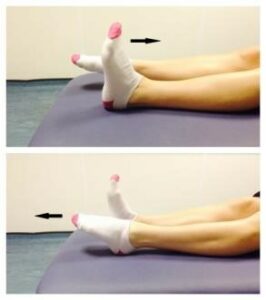
Rest with your leg supported.
Point your foot up and down. Repeat this 10 times.
Inner Range Quads Exercise
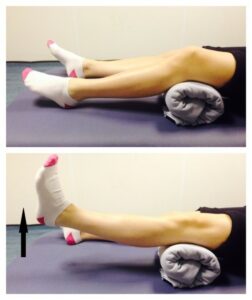
Place a rolled up towel or small pillow under your injured knee.
Tense your thigh muscle and try to straighten your knee. Keep the back of your knee in contact with the towel/pillow.
Repeat 10 times. If you can, try to hold your knee straight for 5 seconds.
Seated knee flexion and extension:
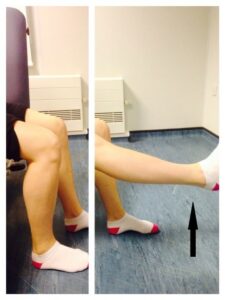
Sit on a chair or on the edge of your bed. Bend and straighten your knee, lifting your heel off the floor.
Repeat this 10 times.
If you can, try holding your knee straight for 5 seconds.
Walking whilst non weight bearing:
Remember to wear your boot whenever you are mobilising. Remember not to put any weight through your foot. You can remove the boot when resting, at night, when doing exercises and to wash and dress. Wear a long sock in your boot. You need to wear the boot for 6 weeks.
Your elbow crutches will be adjusted to the correct height, your forearms should sit within the cuff and hand grips point forward.
To stand:
- Hold the crutches in one hand by the grips
- Push up on the arm of the chair with the other hand, stand on your good leg
- Slip your arms through the arm cuffs
To sit:
- Make sure you are close to the chair so you can feel it at the back of your legs
- Get your balance on your good leg so your injured leg is off the floor
- Take your crutches off your arms
- Hold your crutches by the arm grips or lean them against the chair
- Reach back for the arms of the chair and lower yourself into the chair
- Never stand or sit with your arms in the crutches
Walking Non Weight Bearing with elbow crutches:
- Keep your elbows into your sides
- Place the crutches forwards shoulder width apart to ensure your whole body can fit through the gap
- Lean on the crutches to take weight onto your arms and the crutches
- Step through with your good leg
- When you have your balance, repeat the above steps
Stairs – If you feel unsafe or unsteady, go up and down on your bottom.
If a handrail is available, use it and put your walking aid in the opposite hand. If you have a second crutch, hold it horizontally in the same hand.
- To go upstairs, raise your good leg up first and put your weight on it, then raise your injured leg to the same step, followed by the walking aid. Remember this when going up stairs: Good leg, injured leg, crutch, repeat.
- If going down stairs, move the crutch onto the lower step first, put your weight on the crutch as you move your injured leg onto the step alongside it. Bring your good leg onto the same step. Remember this when going down stairs: Crutch, injured leg, good leg, repeat.
Frequently Asked Questions
I am struggling with my boot. What do I do?
The boot protects your foot and will make you more comfortable. Wear a long sock in your boot. You can take it off at night, at rest or when completing the exercises. Make sure you wear a supportive shoe or trainer on your uninjured foot. This will reduce stress on other joints.
If you need more advice contact the Virtual Fracture Clinic.
I am diabetic, does this change things?
If you are diabetic please contact us to discuss your boot. This is particularly important if you have problems with your skin. We may provide you with a specialist diabetic boot.
When can I start driving?
You can return to driving when:
- You are no longer using your boot
- You can walk comfortably
- You can perform an emergency stop pain free
Always test your ability to drive in a safe environment first.
How can I get a certificate for work?
You can self-certify for the first 7 days following your injury. For any longer periods, please discuss the provision of a fitness to work statement with the Virtual Fracture Clinic Team or your GP.
What do I do with my boot and crutches when I no longer need them?
We are not able to use boots again. These should not be returned to the hospital.
Crutches can be returned to the Fracture Clinic or A&E.
Contact Details for Bedford and Luton
Please contact the hospital where you attended A&E as the other site will not be able to access your notes
BEDFORD HOSPITAL PATIENTS
How do I contact the Virtual Fracture Clinic (VFC)
- Telephone 01234 792036
- Messages will be checked every morning Monday to Friday (except for Bank Holidays)
- Email VFCBedford@bedfordhospital.nhs.uk
How do I contact the Fracture Clinic?
- Telephone 01234 792138
How do I contact the Plaster Room?
- Telephone 01234 792031
- Monday to Friday 9am to 5pm (out of hours contact the Emergency Department)
LUTON & DUNSTABLE HOSPITAL PATIENTS
How do I contact the Virtual Fracture Clinic (VFC)
- Telephone 01582 718121
- Messages will be checked every morning Monday to Friday (except for Bank Holidays)
- Email VFCLuton@ldh.nhs.uk
How do I contact the Fracture Clinic?
- Telephone 01582 497194 or 01582 718 993 (outpatient appointments)
How do I contact the Plaster Room?
- Telephone 01582 491166 (ext. 2233)
- Monday to Friday 9am to 5pm (out of hours contact the Emergency Department)
